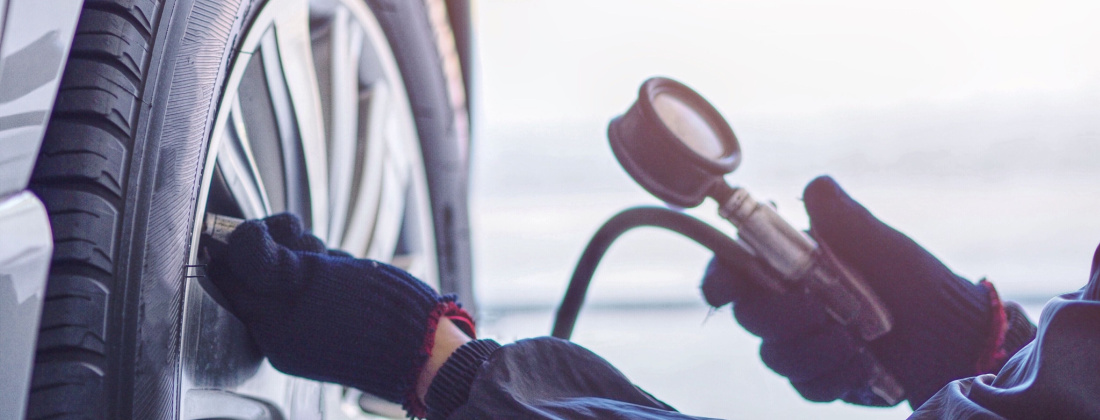Proper Tire Inflation And Tire Safety Checks
October 26, 2022

We all know that properly inflated tires are important for fuel economy and safety. But did you know that according to a recent study, nearly 60% of drivers don’t bother regularly checking their tire pressure?
And of those who do check their tire pressure, many don’t know how to do it properly. As a result, they could be driving around on under-inflated or over-inflated tires, which can lead to all sorts of problems.
In this blog, we’ll show you how to properly check your tire pressure, and explain why it’s so important. We’ll also offer some tips on how to extend the life of your tires. So whether you’re a new driver or a veteran behind the wheel, this blog is for you.
The Importance of Proper Tire Inflation
Tire pressure is critical to road safety and vehicle maintenance. When tires are inflated properly, they last longer, perform better and can help improve your gas mileage.
The Dangers of Under-Inflated Tires
Driving on under-inflated tires is dangerous for a number of reasons. First, under-inflation causes the tire to overheat, which can lead to a blowout. Second, it reduces the tire’s contact patch with the road, which increases the risk of a skid or loss of control. Third, it increases fuel consumption and wear and tear on the tires.
Properly inflated tires are important for safety and fuel economy. Be sure to check your tire pressure regularly, and inflate your tires to the manufacturer’s recommended pressure.
The Benefits of Properly Inflated Tires
It’s no secret that driving on underinflated tires is inefficient and can end up costing you money at the pump. What many people don’t know, however, is that driving on poorly inflated tires can also be dangerous. Here are a few of the benefits of properly inflated tires:
-Improved Fuel Efficiency: Underinflated tires create more rolling resistance, which means your engine has to work harder to move your vehicle down the road. This not only reduces your gas mileage but also puts extra strain on your engine, which can lead to costly repairs down the road.
-Did You Know?: For every 1 PSI drop in tire pressure, fuel economy decreases by 0.4%. (source: U.S. Department of Energy)
-Longer Tire Life: proper inflation helps prevent premature wear and tear on your tires, meaning they’ll last longer and you’ll save money in the long run. Improperly inflated tires will also lose their tread faster, which increases the risk of a blowout or other tire failure.
-Smoother Ride: Properly inflated tires provide a smoother ride for both you and your passengers, making your drive more enjoyable.
-Increased Safety: In addition to premature wear and tear, underinflated tires can also lead to blowouts and other problems that can result in loss of control of your vehicle. According to the National Highway Traffic Safety Administration (NHTSA), 9% of tire-related crashes are caused by underinflation.
How to Check Your Tire’s Inflation
It is important to check your tire’s inflation levels on a regular basis. This will help you avoid a flat tire, blowout, or other issues while on the road. You can check your tire’s inflation levels by using a tire pressure gauge.
Use a Tire Pressure Gauge
To get an accurate reading of your tire pressure, you need to use a tire pressure gauge. You can find a tire pressure gauge at most auto parts stores. Choose a digital tire pressure gauge for the most accurate reading.
How to Use a Tire Pressure Gauge:
- Remove the cap from the tire valve.
- Press the tire pressure gauge onto the valve and hold it there firmly.
- The gauge will give you a reading of the current air pressure in your tire.
- Compare this number to the recommended air pressure for your tires.
- If necessary, add or remove air from your tires using an air compressor until you reach the recommended amount.
- Replace the cap on the tire valve when you’re finished
Check Your Tires at Least Once a Month
Check your tires at least once a month, and before every long trip. Use a good quality tire gauge to check tire pressure. Do not rely on the gauges at gas stations — they are often inaccurate.
To check your tire pressure:
- Remove the cap from the valve stem on one tire.
- Press the gauge firmly onto the valve stem and wait for the reading.
- If the needle points to a number lower than what is listed on the tire, inflate the tire to the proper pressure.
- Replace the cap on the valve stem.
How to Inflate Your Tires
Every driver should know how to properly inflate their tires. It’s a simple task that can easily be done at home, and it could save your life. Here’s how to do it.
Use a Compressor
If you have an air compressor available, this is the quickest and easiest way to inflate your tires. Just attach the compressor to the tire valve, turn it on, and let it do its job. Keep an eye on the pressure gauge, though, as you don’t want to overinflate your tires.
Use a Portable Air Tank
Portable air tanks are useful for a number of purposes, but they’re not always the best option for inflating your tires. If you overfill your tires with a portable air tank, the risk of an explosion is increased. Also, if you don’t have a tire pressure gauge, it’s easy to over- or under-inflate your tires.
Tire Safety Checks
It is important to check your tires on a regular basis to ensure they are properly inflated and free of any damage. This will help to improve your gas mileage and extend the life of your tires. It is also a good safety measure to help prevent flat tires and blowouts.
Check for Cracks or Bulges
If you see any cracks or bulges in your tires, it’s time to replace them. These could lead to a blowout while you’re driving, and that could be very dangerous.
Check the Tread Depth
Worn tires are a leading cause of tire failure. Tread depth is the distance from the top of the tread to the bottom of the deepest groove. The minimum legal tread depth in most states is 2/32″. You can check your tread depth with a tread depth gauge or by placing a penny head first into several tread grooves across the tire. If you can see all of Lincoln’s head, your tread depth is less than 2/32″.
You should also perform a visual inspection of your tires for any cuts, cracks, bulges or uneven wear. These defects can severely reduce the strength of the tire and lead to a sudden loss of tire pressure or a blowout.
Conclusion
It is important to remember that even though we have put together this guide for you, it is still your responsibility to check your tires regularly and ensure that they are properly inflated. Always follow the manufacturer’s recommendations for proper inflation levels. If you have any questions, consult a professional.
Back

